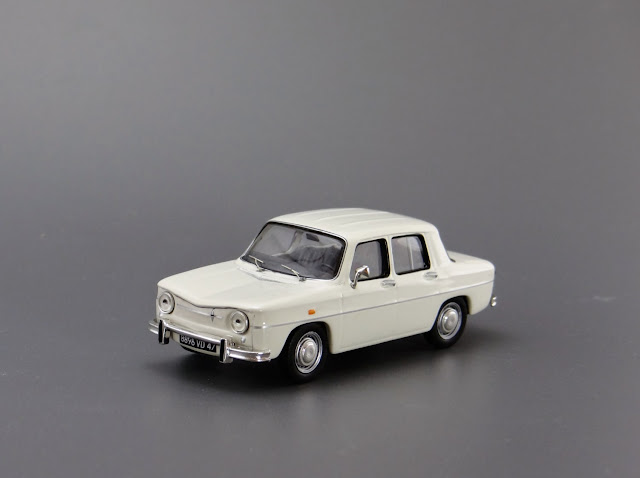R8 kończyło pewną epokę – do
momentu wprowadzenia Renault Twingo III w 2014 roku, było ostatnim masowym
modelem marki z silnikiem z tyłu. Tak jak swój poprzednik – Dauphine
– odniosło rynkowy sukces.
momentu wprowadzenia Renault Twingo III w 2014 roku, było ostatnim masowym
modelem marki z silnikiem z tyłu. Tak jak swój poprzednik – Dauphine
– odniosło rynkowy sukces.
Prace projektowe
ruszyły w 1956 roku a pierwszy prototyp ukończono pod koniec 1959 roku. Renault
nauczone doświadczeniami z poprzednikiem, który nie wytrzymywał eksploatacji w niektórych
klimatach, testowało kolejne egzemplarze na dystansie ponad 1,2
miliona kilometrów w najróżniejszych warunkach drogowych. Auta
testowano zarówno w zimnej Finlandii jak i na bezdrożach
Afryki oraz w równikowym klimacie Gwinei Francuskiej. W ośrodku
badawczym we francuskim Lardy natomiast, przeprowadzono liczne testy
zderzeniowe i próby wytrzymałościowe nadwozia. Nad jego kolorystyką oraz
kolorystyką wnętrza pracował z kolei zespół, podobnie jak w
przypadku Dauphine, z udziałem paryskiej projektantki Paule Marrot.
ruszyły w 1956 roku a pierwszy prototyp ukończono pod koniec 1959 roku. Renault
nauczone doświadczeniami z poprzednikiem, który nie wytrzymywał eksploatacji w niektórych
klimatach, testowało kolejne egzemplarze na dystansie ponad 1,2
miliona kilometrów w najróżniejszych warunkach drogowych. Auta
testowano zarówno w zimnej Finlandii jak i na bezdrożach
Afryki oraz w równikowym klimacie Gwinei Francuskiej. W ośrodku
badawczym we francuskim Lardy natomiast, przeprowadzono liczne testy
zderzeniowe i próby wytrzymałościowe nadwozia. Nad jego kolorystyką oraz
kolorystyką wnętrza pracował z kolei zespół, podobnie jak w
przypadku Dauphine, z udziałem paryskiej projektantki Paule Marrot.
Gotowy samochód zaprezentowano publiczności 16 czerwca 1962 roku. R8 opierał się technicznie na swoim poprzedniku, ale gołym okiem nie sposób było to dostrzec. Wychodzące z mody nadwozie typu ponton zastąpiła modna, pudełkowata sylwetka narysowana przez Gastrona Jucheta i Philippe’a Charbonneaux. Uwagę szczególnie przykuwał ciekawy zabieg stylistyczny z załamaną pokrywą bagażnika (pamiętajmy, auto ma silnik z tyłu, więc bagażnik jest z przodu!)
Wykorzystanie platformy z poprzednika oznaczało taki sam rozstaw osi – 227 cm. Pomimo tego oraz węższego o 3 cm nadwozia, we wnętrzu wygospodarowano znacznie więcej miejsca. Bagażnik mieścił 241 litrów a przednie fotele były aż o 6cm szersze.
To, że R8 bazowało na poprzedniku nie
oznaczało jednak, iż technicznie było identyczne. O, nie! Swego
rodzaju przełomem było zastosowanie hamulców tarczowych systemu
Lockhead-Bendix przy wszystkich kołach. Dzisiaj nie robi to wrażenia,
ale na początku lat 60. nie wszystkie luksusowe samochody posiadały takie rozwiązanie,
a co dopiero kompakty. Silnik również był całkiem nowoczesny. Chłodzona cieczą, 4-cylindrowa
jednostka o pojemności 956 cm³ i mocy 43 KM była pierwszą z
rodziny Cléon-Fonte. Co ciekawe, silniki z tej rodziny przetrwały aż do wczesnych lat XXI
wieku i były montowane jeszcze np. w Twingo i Clio.
oznaczało jednak, iż technicznie było identyczne. O, nie! Swego
rodzaju przełomem było zastosowanie hamulców tarczowych systemu
Lockhead-Bendix przy wszystkich kołach. Dzisiaj nie robi to wrażenia,
ale na początku lat 60. nie wszystkie luksusowe samochody posiadały takie rozwiązanie,
a co dopiero kompakty. Silnik również był całkiem nowoczesny. Chłodzona cieczą, 4-cylindrowa
jednostka o pojemności 956 cm³ i mocy 43 KM była pierwszą z
rodziny Cléon-Fonte. Co ciekawe, silniki z tej rodziny przetrwały aż do wczesnych lat XXI
wieku i były montowane jeszcze np. w Twingo i Clio.
Na targach motoryzacyjnych w Paryżu we wrześniu
1962 roku przedstawiono R8 z automatyczną skrzynią biegów
firmy Jaeger ze sprzęgłem sterowanym elektrycznie. Do dyspozycji
kierowcy były trzy przełożenia do jazdy w przód i jedno do jazdy w tył.
Inspiracją dla konstruktorów było niemieckie urządzenie Saxomat montowane
w wielu europejskich autach w latach 50. i 60. R8 Automatic nie zdobyło
jednak uznania europejskich klientów.
1962 roku przedstawiono R8 z automatyczną skrzynią biegów
firmy Jaeger ze sprzęgłem sterowanym elektrycznie. Do dyspozycji
kierowcy były trzy przełożenia do jazdy w przód i jedno do jazdy w tył.
Inspiracją dla konstruktorów było niemieckie urządzenie Saxomat montowane
w wielu europejskich autach w latach 50. i 60. R8 Automatic nie zdobyło
jednak uznania europejskich klientów.
Renault przez cały okres produkcji R8
starało się utrzymać zainteresowanie nim. W 1964 roku przedstawiono
model 8 Major z silnikiem o pojemności 1108 cm³ i mocy 50 KM i
zsynchronizowaną skrzynią oraz kultową odmianę
Gordini z silnikiem o mocy 90 KM. Rok później modyfikacjom poddano wnętrze a
z oferty usunięto najsłabszą jednostkę napędową 956
cm³.
starało się utrzymać zainteresowanie nim. W 1964 roku przedstawiono
model 8 Major z silnikiem o pojemności 1108 cm³ i mocy 50 KM i
zsynchronizowaną skrzynią oraz kultową odmianę
Gordini z silnikiem o mocy 90 KM. Rok później modyfikacjom poddano wnętrze a
z oferty usunięto najsłabszą jednostkę napędową 956
cm³.
Tak jak swój poprzednik, „ósemka” cieszyła się
międzynarodowym powodzeniem. Eksportowano go do
ponad 80 państw a produkowano aż w 12. Oprócz macierzystej fabryki we
francuskim Flins, produkcją zajmowały m.in. zakłady FASA-Renault w Hiszpanii,
SOMA w Kanadzie oraz fabryki w Bułgarii wytwarzające model pod marką
Bulgarrenault. Od 1968 roku, na licencji, auto wytwarzano też w Rumunii jako
Dacia 1100. Przyjmuje się, że kariera rynkowa Renault 8 zakończyła się w 1973
roku. Dokładne daty zakończenia produkcji różniły się jednak między fabrykami.
Najdłużej R8 produkowano w hiszpańskich zakładach FASA-Renault, bo do 1976
roku.
międzynarodowym powodzeniem. Eksportowano go do
ponad 80 państw a produkowano aż w 12. Oprócz macierzystej fabryki we
francuskim Flins, produkcją zajmowały m.in. zakłady FASA-Renault w Hiszpanii,
SOMA w Kanadzie oraz fabryki w Bułgarii wytwarzające model pod marką
Bulgarrenault. Od 1968 roku, na licencji, auto wytwarzano też w Rumunii jako
Dacia 1100. Przyjmuje się, że kariera rynkowa Renault 8 zakończyła się w 1973
roku. Dokładne daty zakończenia produkcji różniły się jednak między fabrykami.
Najdłużej R8 produkowano w hiszpańskich zakładach FASA-Renault, bo do 1976
roku.
O miniaturze
Autko to obecna już od lat pozycja wydawnictwa Altaya. Przyśpieszonego bicia serca u nikogo nie wywoła – zdecydowanie za gruba warstwa lakieru (miejscami nierówno położona) i kiepskie przednie reflektory nie wyglądają dobrze. Dodatkowo, proporcje nadwozia nie do końca się zgadzają. Modelik sprawia wrażenie trochę wyciągniętego względem oryginału. Zmiana jakiej tutaj dokonałem to zamontowanie fototrawionych wycieraczek.
*********
The R8 marked an end of an era – up until the arrival of Renault Twingo III in 2014, it was the company’s last mass produced rear-engine model. Just like its predecessor – the Dauphine – it was highly successful.
Development began in 1956 with the first prototype being completed by the end of 1959. Renault taught by the experiences from the previous model, which didn’t cope well with certain climates, tested several prototypes in various conditions on a distance of over 1.2 million kilometres. The cars were tested in cold Finland, on deserted roads of Africa and equatorial climate of French Guinea. Meanwhile in a research centre in Lardy, several crash tests and endurance tests of the bodyshell were conducted. Its colours and colours of the interior were on the other hand developed by a team including, similarly to Dauphine, the French textile designer Paule Marrot.
The finished car was presented to the public on 16th June 1962. The R8 was based on its predecessor, but there was no way of telling it with the naked eye. Coming out of fashion ponton genre design was replaced with fashionable, boxy styling drawn by Gastron Juchet and Philippe Charbonneaux. A particularly striking design feature was the crease in the middle of the boot lid (remember, the car is rear-engined, so the boot’s at the front!)
Using the predecessor’s floorpan meant the same wheelbase – 227 cm. Despite this and a 3cm narrower body, the interior was much more spacious. The boot capacity was 241 litres and front seats were 6 cm wider.
However, basing
the R8 on its predecessor didn’t mean it was mechanically identical. Definitely
not! A sort of a breakthrough was fitting of four-wheel Lockhead-Bendix disc
brakes. Today it wouldn’t set the world on fire, but in the early 60s not all
luxurious cars had them, never mind small family cars. The engine was also
relatively modern. Water cooled, 4-cylinder, 956 cc unit developing 40 hp was
the first of the Cléon-Fonte family. Interestingly, engines from this family
survived until early XXI century and were used in cars such as the Twingo and
Clio.
the R8 on its predecessor didn’t mean it was mechanically identical. Definitely
not! A sort of a breakthrough was fitting of four-wheel Lockhead-Bendix disc
brakes. Today it wouldn’t set the world on fire, but in the early 60s not all
luxurious cars had them, never mind small family cars. The engine was also
relatively modern. Water cooled, 4-cylinder, 956 cc unit developing 40 hp was
the first of the Cléon-Fonte family. Interestingly, engines from this family
survived until early XXI century and were used in cars such as the Twingo and
Clio.
At the
September 1962 Paris Motor Show an R8 with an automatic transmission of unique
design, developed and produced by Jaeger was presented. It had three forward gears
and one reverse gear. It was inspired by the German Saxomat device which
appeared on many European cars in the 1950s and 60s. However, the R8 Automatic
wasn’t popular among European buyers.
September 1962 Paris Motor Show an R8 with an automatic transmission of unique
design, developed and produced by Jaeger was presented. It had three forward gears
and one reverse gear. It was inspired by the German Saxomat device which
appeared on many European cars in the 1950s and 60s. However, the R8 Automatic
wasn’t popular among European buyers.
Throughout the
production span of the R8, Renault strived to maintain its appeal. In 1964 the
8 Major appeared featuring a 1108 cc engine developing 50 hp and synchronised
transmission followed by the cult Gordini variant with a 90 hp engine. A year
later the interior was slightly updated and the basic 956 cc engine was removed
from the line-up.
production span of the R8, Renault strived to maintain its appeal. In 1964 the
8 Major appeared featuring a 1108 cc engine developing 50 hp and synchronised
transmission followed by the cult Gordini variant with a 90 hp engine. A year
later the interior was slightly updated and the basic 956 cc engine was removed
from the line-up.
Just like its
predecessor, the „eight” celebrated international success. It was exported to
over 80 countries and produced in as many as 12. Apart from the mother factory
in French Flins, production was launched, among others, in the FASA-Renault
plant in Spain, SOMA plant in Canada and factories in Bulgaria producing it
under the Bulgarrenault brand. From 1968 the car was also produced in Romania,
under license, as a Dacia 1100. It is accepted that Renault 8’s career ended in
1973. However, the exact dates of production end differ between factories. The
R8 was produced the longest in the Spanish FASA-Renault plant, up until 1976.
predecessor, the „eight” celebrated international success. It was exported to
over 80 countries and produced in as many as 12. Apart from the mother factory
in French Flins, production was launched, among others, in the FASA-Renault
plant in Spain, SOMA plant in Canada and factories in Bulgaria producing it
under the Bulgarrenault brand. From 1968 the car was also produced in Romania,
under license, as a Dacia 1100. It is accepted that Renault 8’s career ended in
1973. However, the exact dates of production end differ between factories. The
R8 was produced the longest in the Spanish FASA-Renault plant, up until 1976.
About the miniature
The car is
Altaya’s offering that has been around for years. It won’t make anyone’s heart
racing – much too thick paintwork (uneven in places) and dodgy front lights
just don’t look good. Additionally, the model’s proportions seem to be off.
When compared to the original, the model seems to be somewhat elongated. A
change I made in this model is the addition of photoetched wipers.
Altaya’s offering that has been around for years. It won’t make anyone’s heart
racing – much too thick paintwork (uneven in places) and dodgy front lights
just don’t look good. Additionally, the model’s proportions seem to be off.
When compared to the original, the model seems to be somewhat elongated. A
change I made in this model is the addition of photoetched wipers.
 |
| Renault 8 1964 (1:43) by IXO Part of Altaya partwork series |















